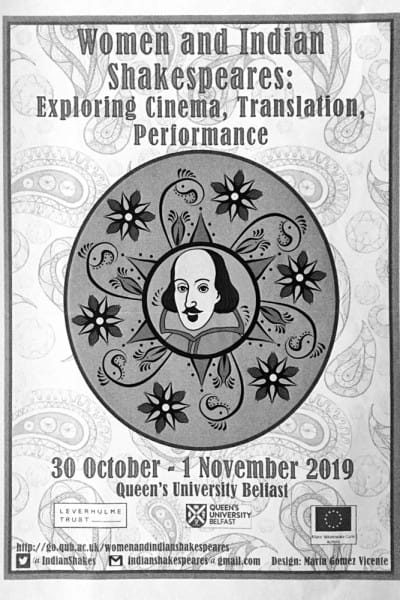Shakespearewallah: From Bengal to Belfast

Here we are on the Irish border for Hallowe'en, originally a Celtic festival designed to propitiate the ghosts of the dead.
October 31st this year was the date the current British PM proposed for Brexit, bastard child of an essentially English nationalism that raises the spectre of Irish Partition and may yet result ironically, final Imperial spasm, in the Partition of the UK.
Hallowe'en has come and gone without Brexit and we have spent it instead in Befast, a place like Bangladesh, as friendly and hospitable personally as it has been troubled politically. The majesterial Queen's University has been hosting a conference on, believe it or not, Women and Indian Shakespeares.
Although the 50 or so scholars from all over the world did not ask the question of what Shakespeare has to do with the Subcontinent, they did ask what on earth he has done for women there. "Shakespeare," we take as a given, is a grab-bag of fables wrenched into arresting dramatic shape and expressed in unsurpassed poetry, growing ever fatter and out of shape since the death of the Bard. The plays are a standard and a challenge for newer generations of artists, in English and other languages, moving on into novels and films.
Introduced into the Subcontinent as an Imperial icon, this ongoing "Shakespeare," at once canonical and blown from the cannons, has wittingly and unwittingly exposed divisions in society based on nationality, community, class and gender - and ultimately within the self.
The keynote speech at Queen's traced just how hard it was for Indian women to muscle in on the male monopoly of Shakespeare.
Shakespeare not only offers few roles for women but 19th century India, like Shakespeare's England, did not permit women, respectable or orherwise, to act onstage - hence the great Marathi female impersonators - or even educate themselves to discuss the issues his work raises. To speak only of Bengal, Shakespeare was initially taught to boys as moral tales: Lambs Tales to the slaughter.
One intriguing Bengali dimension is provided by Bankim's novel, Kapalkundala, set in Mughal India in Shakespeare's time. Out of The Tempest, yes, but also the classical Sanskrit theatre, the eponymous Hindu "Miranda" is raised like Caliban as a Child of Nature. New man Nabakumar, "Ferdinand." is even-handed enough to have a Muslim wife as well as Kapalkundala but, as Rabindranath was to observe, Bankim's novel castigates the way a Bengali woman is treated whatever her religion or caste.
Utpal Dutt no less than Prithvi Raj schooled himself in Shakespearewallah and one result of this has been a series of films - Aparna Sen's 36 Chowringhee Lane and Rituparno Ghosh's The Last Lear - culminating in one highlight of the Queen's adda: Sangeeta Datta's Life Goes On.
In Life Goes On, King Lear is translated to contemporary London transmuted by the sensibility of Rabindra Sangeet. The film is almost a prequel since it is centred on the missing mother (Sharmila Tagore) and it is only when she dies that Lear's relationship with Dia, "Cordelia," comes to the fore. It is Dia's taking up with and getting pregnant by a young Bangladeshi doctor that brings down on her the wrath of her father, a Hindu patriarch who as a boy saw his family driven out of Dhaka by Partition.
Dr Banerji (Girish Karnad), after a night out in a storm that lands him up on Hampstead Heath, learns remorse and reconciliation and, like the revised version of the play done by Nahum Tate, England's first Irish Poet Laureate, the story has a happy ending.
There is no question but that women are now fully engaged with Indian Shakespeares. It is only 30 years ago that Amal Allana in Delhi broke new ground as a woman director with her staging of King Lear, but film especially and the novel have opened the floodgates.
The problem is less the position of Indian women, the educated ones at any rate, than Shakespeare's women. Victorian India took up with Shakespeare initially on account of Desdemona especially: how well she accorded with Sakuntala, Savitri and, above all, Sati.
Datta has retrieved the absent mother for us in her Lear but she still has to kill her off, even though it is her ghost who haunts the rest of the story. What do you do if you don't want a Shakespeare heroine who, powerless or overpowered, sacrificed or self-sacrificing, is not to be killed - or, for that matter, married - off?
The only way is to make merry with Shakespeare's plots and characters. In Eastwords, Kalyan Ray marries The Tempest to A Midsummer Night's Dream in a novel that includes even Siraj-ud-Daula. In the 17th century, Davenant, Dryden and that dunce Shadwell had already deviated into Nonsense with a grab-bag of an operatic Tempest.
Earlier this year, Dhaka saw the students of ULAB perform Caliban, a sequel to The Tempest that allows Rani Drew to dispense with Shakespeare's text, displace Prospero with Sycorax (Ray's Sukumari) and have Ariel and Caliban, hitherto divided and ruled, combine to create a free and independent island.
Drew had begun writing back to Shakespeare with a three-act Hamlet framed by Ophelia's ghost and followed that up with a Cleopatra where the eponymous ghost, free of the attentions of Caesar and Antony, gives us her side of Shakespeare's story.
In her Shakespeare and Me, a couple of young Hungarian women, loosely based on Celia and Rosalind in As You Like It, turn the best-known monologues of Shakespeare's women upside down and inside out.
But no more Satis, please, on stage or in life. Lay those ghosts to rest this Hallowe'en.
John Drew, who interviewed Utpal Dutt on the subject of Bengali Shakespeares for the BBC in 1964, has been catching up on the subject.

 For all latest news, follow The Daily Star's Google News channel.
For all latest news, follow The Daily Star's Google News channel. 



Comments